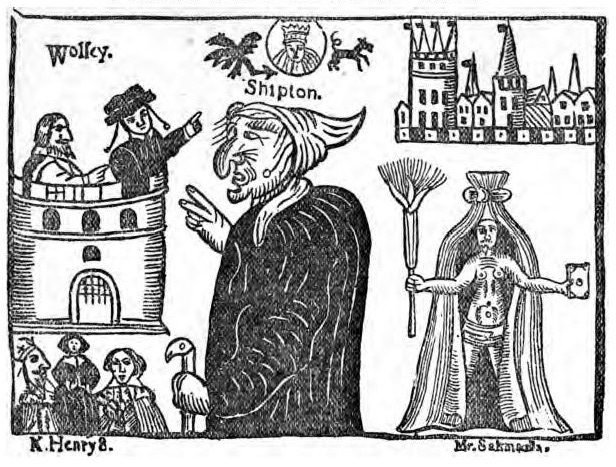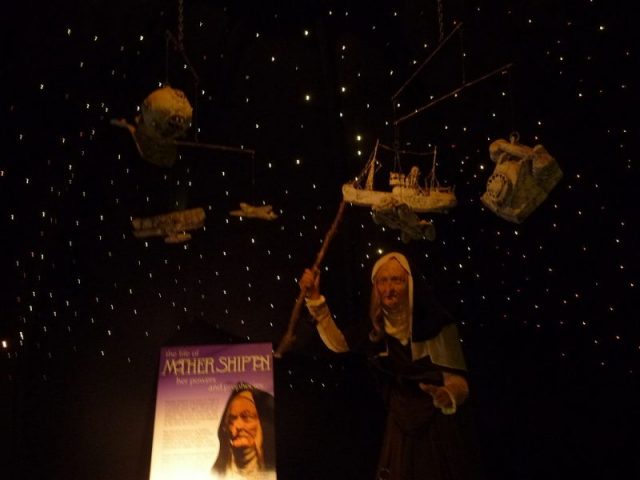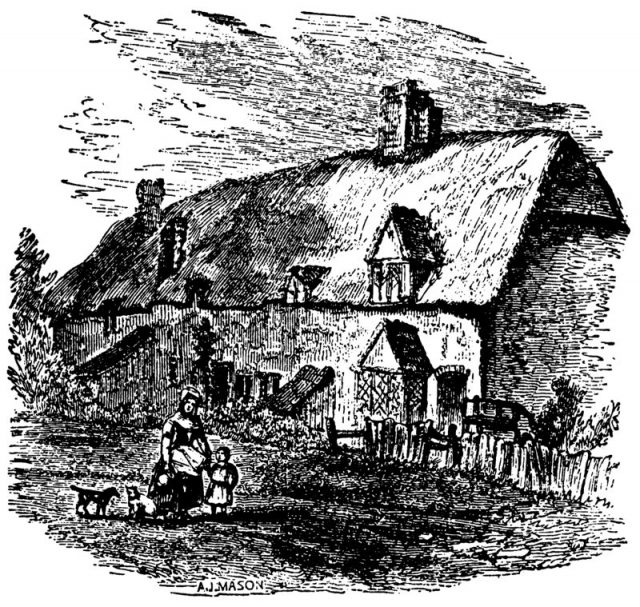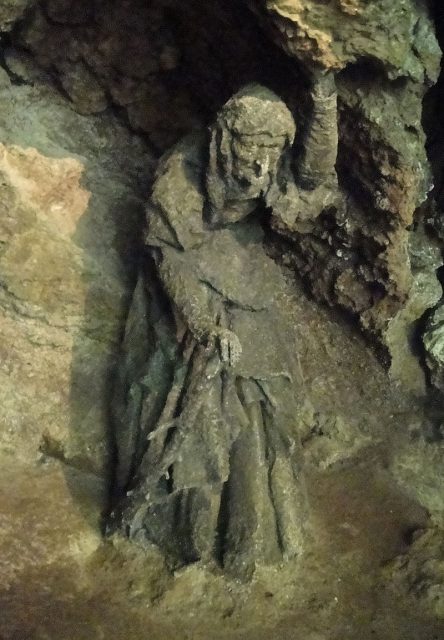Mother Shipton still provides a scare to British folklorists. In the spring of 1881, families across England deserted their homes, too terrified to sleep in their beds. They slept in fields or prayed in churches and chapels for God to spare their lives in the apocalypse that was foretold: “The world to an end shall come; in eighteen hundred and eighty-one.”
The source of the population’s terror was Mother Shipton, also known as Ursula Shipton, a woman whose prophecies had been circulating through England and beyond since the 17th century.
In often cryptic verse, the crone-like seer predicted wars, rebellions, and all types of natural disasters. After London burned in 1666, Samuel Pepys wrote in his diary: “Mother Shipton’s word is out.” Her prophecies were published in one form or another over 20 times between 1641 and 1700.
But in the 1800s, her predictions grew even more terrifying: The end-of-the-world was foretold in a book published in 1862. Its other prophetic verse included: “A carriage without a horse shall go; Disaster fill the world with woe; In water iron then shall float; As easy as a wooden boat.”
The world did not end in 1881. People began sleeping in their beds once more. It was not the first time that fear of a Mother Shipton prediction convulsed a nation and it would not be the last.

Today there is considerable skepticism that a prophetess named Mother Shipton ever existed. Many of her written predictions are, after all, confirmed forgeries, created to sell greater numbers of chapbooks and almanacs. Her 1684 “biographer” spun spooky details of her birth and existence; the 1881 end-of-the-world prophecy was debunked when the Victorian editor Charles Hindley publicly confessed to concocting the verses himself.
Nonetheless, belief in Mother Shipton persisted. Today a thriving tourist attraction called Mother Shipton’s Cave, at Knaresborough, North Yorkshire, features the cave where she was born and the petrifying well where objects can turn to stone. There’s also a shop selling mugs, tea towels, thimbles, and wishing-well water in dark pink, ruby red, and kelly green.
But just because Mother Shipton has become the label on kelly-green wishing-well water does not mean that she has no basis in fact. Like Robin Hood or King Arthur, it’s believed that if we were able to trace the myth-making back to the very beginning, a living, breathing person could be identified.

There are no written references to Mother Shipton in the 1500s. That name does not appear in print until 1641; prophecies in her name didn’t exist in her lifetime or for decades afterward. But a mention of a “witch of York” in a chilling letter written by King Henry VIII himself could be the elusive source of the legend.
The context of the letter is critical. It was written to Thomas Howard, duke of Norfolk, while the duke was in the middle of a clean-up operation following the Northern rebellion against the king known as the Pilgrimage of Grace. Thousands of commoners and a fair number of nobles rose up against the reforms in religion forced on the country by Henry VIII. The rebels were particularly upset by the fresh taxes and the closing of the monasteries, which in the poorer regions of the North were needed sources of food, shelter, and medical care.
The Duke of Norfolk had defeated this 1537 outbreak, which followed the main rebellion of 1536, and he was now imprisoning and then executing people without trial, imposing martial law. He wrote his king that he hanged more than 70.

Henry VIII, who wanted harsh measures taken against the rebels, dictated the following letter to Norfolk in response:
“We approve of your proceedings in the displaying of our banner, which being now spread, till it is closed again the course of our laws must give place to martial law; and before you close it up again, you must cause such dreadful execution upon a good number of inhabitants, hanging them on trees, quartering them, and setting their heads and quarters in every town, as shall be a fearful warning, whereby shall ensue the preservation of a great multitude… You shall send up to us the traitors Bigod, the friar of Knareborough, Leche, if he may be taken, the vicar of Penrith and Towneley, late chancellor to the bishop of Carlise, who has been a great promoter of these rebellions, the witch of York and one Dr. Pykering, a canon. You are to see to the lands and goods of such as shall now be attainted, that we may have them in safety, to be given, if we be so disposed, to those who have truly served us…”
“The witch of York”…could this be a contemporary reference to a woman who not only caused enough trouble to incite the wrath of Henry VIII but also transformed into Mother Shipton?
Her legend grew and grew in the 1600s, in published almanacs: Ursula was born in a cave in 1488, the child of an orphan servant girl and an unknown father–perhaps Lucifer himself. She was singularly ugly, called “Devils Bastard” and “Hag-face.” Nonetheless, Ursula married a builder named Toby Shipton and lived quietly with him, never prosecuted for witchcraft though regularly uttering prophecy. “Her stature,” wrote her biographer, “was larger than common, her body crooked, her face frightful; but her understanding extraordinary.” How much of this describes the “witch of York” described by Henry VIII is unknown.

CC BY 3.0
The fact that Mother Shipton’s first known prediction concerned the fate of Cardinal Wolsey is significant. According to Wolsey’s gentleman usher and later biographer, George Cavendish, Wolsey, near the end of his life, was disturbed by a prophecy he heard. Cavendish wrote: ” ‘There is a saying, quoth he, ‘that When this cow rideth the bull, then priest beware thy skull.” According to Tudor-court interpretation, the cow was Anne Boleyn, who in her holding sway over Henry VIII and convincing him to divorce his queen to marry her, triggered the break with the Catholic Church. Mother Shipton was not attributed to this prophecy by Cavendish. But in the future, her soothsaying would intertwine with Wolsey’s fate.
Belief in prophecy ran through every level of Tudor society. It reached a fever pitch during the dangerous 1530s, when queens and courtiers were beheaded, monasteries fell, and rebels were hanged from trees across the North of England.

CC BY 3.0
Many prophecies were used for political purposes. Uprisers against Henry VII said they were following the ancient sages. The rebels of the Pilgrimage of Grace cried that Henry VIII was the ancient “Mouldwarp,” a monster ruler foretold by Merlin who would be “cast down.” Anthony Babington, who conspired to assassinate Elizabeth I, carried a prediction of Merlin’s sayings. One popular prophecy during Elizabeth’s time was “When HEMPE is soon, England’s done.” HEMPE was thought to stand for Henry-Elizabeth-Mary-Philip-Elizabeth.
Madeleine Dodds in Political Prophecies in the Reign of Henry VIII wrote: “Political prophecies tended to be invoked at a time of crisis, usually to demonstrate that some drastic change, either desired or already accomplished, had been foreseen by the sages of the past.”
In the 1700 and 1800s, Mother Shipton’s prophecies broadened to cataclysmic disasters, amazing inventions, and, of course, the end of the world. Stripped of politics, they were more potent than ever. Perhaps they filled a deep craving within to feel that everything happens by some design, even if it is drawn by an ancient mystic, sage or witch. We are all of us fulfilling an obscure and coded destiny.
It’s a craving that we still see around us today. It just might be part of being human.
Nancy Bilyeau, the U.S. editor of The Vintage News, has written a trilogy of novels set in the court of Henry VIII: ‘The Crown,’ ‘The Chalice,’ and ‘The Tapestry.’ The books are for sale in the U.S., the U.K., and seven other countries. For more information, go to www.nancybilyeau.com.
